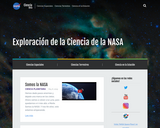
This resource is a photography that illustrates the basic differences between plant and animal cells.
- Subject:
- Science
- Material Type:
- Diagram/Illustration
- Provider:
- Utah Education Network
- Author:
- Utah Lesson Plans
- Date Added:
- 02/26/2019

This resource is a photography that illustrates the basic differences between plant and animal cells.

This is an activity about image comparison. Learners will analyze and compare two sets of images of the Sun taken by instruments on the Solar Dynamics Observatory spacecraft. With Set 1, they will observe the Sun in both a highly active and a minimally active state, and be able to detect active regions and loops on the Sun by comparing the two images. With Set 2, they will identify areas of high magnetic activity on a magnetogram image and recognize that these areas correspond to highly active regions on the Sun.

Students are presented with a graph of atmospheric becomes CO² values from Mauna Loa Observatory, and are asked to explore the data by creating a trend line using the linear equation, and then use the equation to predict future becomes CO² levels. Students are asked to describe qualitatively what they have determined mathematically, and suggest reasons for the patterns they observe in the data. A clue to the reason for the data patterning can be deduced by students by following up this activity with the resource, Seasonal Vegetation Changes. The data graph and a student worksheet is included with this activity. This is an activity from Space Update, a collection of resources and activities provided to teach about Earth and space. Summary background information, data and images supporting the activity are available on the Earth Update data site.

This resource is an image of the water cylce that accompanies the lesson plan, "Changing State - Condensation."

This resource an image that accompanies the lesson plan, "Changing State - Evaporation."

This resource is an animation that accompanies the lesson plan, "Changing State - Evaporation."

This resource poster provides illustrations and descriptions of the forces and factors such as mass and torque that are involved with the swing of a baseball bat.

Chronological List of Emperors with dates of their rule and images of: Augustus, Tiberius, Caligula, Titus, Trajan, Hadrian, Antoninus Pius, Caracalla, Trebonianus Gallus, Constantine. Images are shown from a variety of media: sculpture, coins and a ring with intaglio portrait.

On behalf of Marcus Caelius in the spring of 56 B.C.E. Roman oratory was a living art. Orators knew that the persuasive power of a speech did not come from the force and clarity of its argument alone. A speaker needed not simply to be heard distinctly, but to project the kind of confident, engaging personality that could win an audience's good will and command its belief.

ofrece las ltimas noticias de la ciencia. La clase de jueves proporciona nuevos planes y actividades de la leccin basados en una historia actual del ttulo y conecta la ltima investigacin de NASA con la instruccin. Pasados asuntos incluyen Buck Rogers, Cuidado!, Adis a la MIR, Despus de tres intentos, se retira La Nia?, y ms.

Students will label items found in a classroom.

This series of 7 captioned images depict sources, causes and results of carbon dioxide and greenhouse gas emissions. This lesson is part of the Climate Kids website, a NASA education resource featuring articles, videos, images and games focused on the science of climate change.

This series of 28 captioned images depict some the positive and some of the negative influences on the global carbon cycle, including industrial pollution, deforestation, waste disposal, transportation, and recycling. The Climate Kids website is a NASA education resource featuring articles, videos, images and games focused on the science of climate change.

This series of 11 captioned images depict the harnessing of three types of alternative energy sources: tidal, wind and solar. In contrast, several images of fossil fuel usage are included. The Climate Kids website is a NASA education resource featuring articles, videos, images and games focused on the science of climate change.

This series of 12 captioned images depict some of the issues facing Earth’s fresh water supply, such as pollution, drought, and glacial retreat. The Climate Kids website is a NASA education resource featuring articles, videos, images and games focused on the science of climate change.

This series of 16 captioned images depict representative plant and animal species threatened by climate change. In contrast, images of healthy plants are also shown to emphasize their role in removing carbon dioxide from the atmosphere. The Climate Kids website is a NASA education resource featuring articles, videos, images and games focused on the science of climate change.

This series of 9 captioned images depict green technologies that convert wind, sunlight and tides into electricity and also convert seawater to freshwater. The Climate Kids website is a NASA education resource featuring articles, videos, images and games focused on the science of climate change.

This series of 18 captioned images depict several weather and climate-related events such as flooding, drought, glacial retreat and wind erosion. The Climate Kids website is a NASA education resource featuring articles, videos, images and games focused on the science of climate change.

One of Earth's vital signs, the extent of sea ice cover in the Arctic, is examined. An image and accompanying text describe the extent and consequences of the reduction in that sea ice. This article is part of the Climate Kids website, a NASA education resource featuring articles, videos, images and games focused on the science of climate change.

Houses, some with floor space of less then 100 square feet, can leave a small carbon footprint. This article describes those "tiny houses," and gives additional reasons some people choose to live in them. Photos of several are included. The Climate Kids website is a NASA education resource featuring articles, videos, images and games focused on the science of climate change.